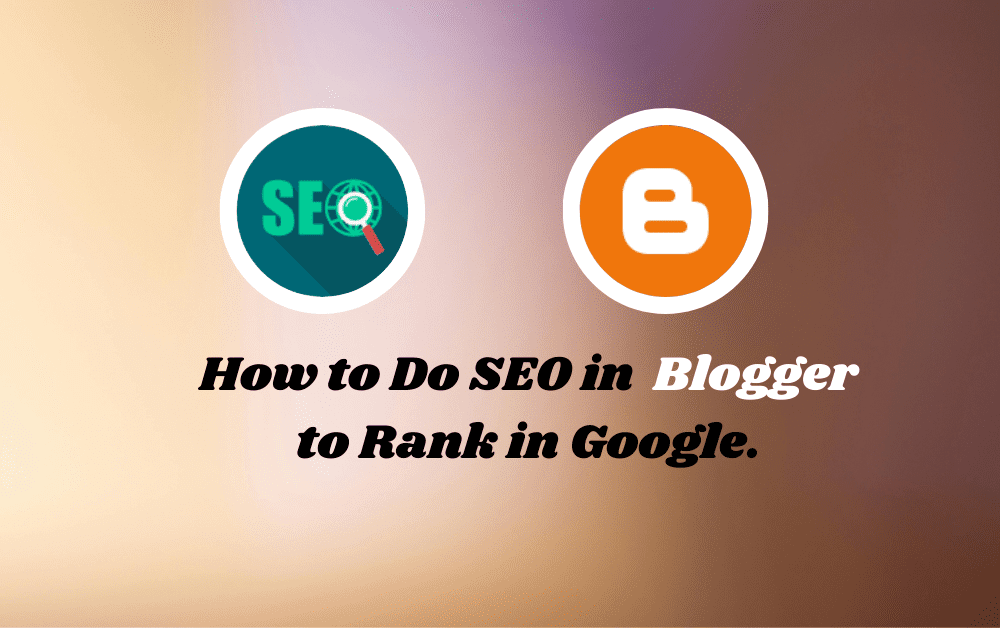🚀 How to Do SEO in Blogger to Rank in Google
Search Engine Optimization (SEO) is essential for ranking your Blogger website on Google. Blogger, a free blogging platform by Google, provides basic SEO features, but optimizing your content and settings correctly can significantly improve your rankings. Below are the steps to optimize your Blogger site for better search engine visibility.
🔍 1. Choose an SEO-Friendly Blog Niche
Before creating content, select a niche that has demand but is not overly competitive. Research keywords and topics with tools like Google Keyword Planner, Ubersuggest, or Ahrefs to ensure your niche has sufficient search volume.
🌍 2. Use a Custom Domain
Instead of using the default yourblog.blogspot.com, purchase a custom domain (e.g., yourblog.com). Custom domains look more professional and improve trust, which enhances SEO rankings. You can buy domains from providers like Namecheap, GoDaddy, or Google Domains.
⚙️ 3. Optimize Blogger Settings
✅ Enable Search Engine Visibility
Go to Settings > Privacy and ensure that “Visible to search engines” is enabled.
📝 Set Custom Robots.txt
A custom robots.txt file helps guide search engine crawlers. To add one:
Go to Settings > Crawlers and Indexing
Enable “Custom robots.txt”
Paste the following SEO-friendly robots.txt file:
User-agent: *
Disallow: /search
Allow: /
Sitemap: https://yourblog.com/sitemap.xml
🏷️ Add Custom Meta Tags
Go to Settings > Meta tags
Enable “Meta description” and add a brief, keyword-rich description of your blog (up to 150 characters).
🎯 Configure Custom Robots Header Tags
Go to Settings > Crawlers and Indexing > Custom robots header tags
Configure them as follows:
Homepage: all, noodp
Archive and search pages: noindex, noodp
Post and pages: all
🎨 4. Choose an SEO-Friendly Theme
A fast, responsive, and mobile-friendly theme is crucial for rankings. Use lightweight, SEO-optimized themes like Contempo, Emporio, or third-party Blogger themes from sites like ThemeForest.
🔗 5. Improve URL Structure
Blogger generates URLs automatically, but you can optimize them:
Use Custom Permalink when publishing posts.
Keep URLs short and include primary keywords (e.g., best-seo-tips instead of how-to-do-seo-on-blogger-platform).
✍️ 6. Optimize Your Blog Posts
🔎 Keyword Research
Use tools like Google Keyword Planner, Ahrefs, or SEMrush to find low-competition, high-volume keywords.
🎯 Write SEO-Friendly Titles
Ensure your titles are catchy, include the main keyword, and stay under 60 characters.
📑 Use Proper Headings
Use H1 for the main title, H2 for subheadings, and H3/H4 for further divisions to improve readability and SEO.
🖼️ Optimize Images
Compress images before uploading using TinyPNG or Compressor.io.
Add alt text (image description) with keywords.
🔗 Internal and External Linking
Link to related blog posts within your content (internal linking).
Link to authoritative sources when referencing data (external linking).
🏆 Write High-Quality Content
Create unique, engaging, and well-structured content (1000+ words preferred).
Avoid keyword stuffing and aim for a natural keyword placement.
⚡ 7. Improve Blog Loading Speed
Use lightweight themes.
Compress images.
Avoid excessive widgets.
Enable lazy loading for images.
Use fast-loading third-party templates if necessary.
🗺️ 8. Create an XML Sitemap
Blogger automatically generates a sitemap. Submit it to Google:
Go to Google Search Console.
Navigate to Sitemaps.
Enter sitemap.xml (e.g., https://yourblog.com/sitemap.xml).
Click “Submit” to help Google index your content faster.
🔗 9. Build Quality Backlinks
Backlinks from authoritative sites boost rankings. Strategies include:
Guest posting.
Social media promotion.
Submitting to blog directories.
Commenting on relevant blogs with a link to your blog
📱 10. Optimize for Mobile
Since most traffic comes from mobile devices, ensure:
Your blog is mobile-friendly.
Fonts and buttons are easily readable and clickable.
Mobile page speed is optimized.
🛠️ 11. Use Structured Data Markup
Implement structured data to help Google understand your content better. Use JSON-LD schema for articles and blogs by adding it in Theme > Edit HTML.
📊 12. Track Performance with Analytics
Use Google Search Console to track indexed pages, search queries, and errors.
Install Google Analytics to monitor traffic and user behavior.
📢 13. Promote Your Blog
Share posts on social media platforms.
Engage in relevant forums and Q&A sites like Quora and Reddit.
Use email marketing to build an audience.
🔄 14. Update Old Content
Regularly update old posts to keep content fresh and improve rankings. Add new keywords, images, and internal links.
🎯 Conclusion
SEO on Blogger requires strategic content optimization, technical settings, and continuous improvement. By implementing these steps, you can improve your Blogger site’s visibility, attract organic traffic, and rank higher on Google. 🚀




